[Editor's Note: We want Islanders on both sides of the border to know more about Turtles. This summer we learned about Turtles Kingston, a volunteer organization with an important vision: Our vision at Turtles Kingston is to reach a day when all 8 Ontario turtle species are no longer at risk.
They are working diligently to bring more public awareness to the plight of turtles through advocacy, education, volunteering, and collaboration. The Thousand Islands Association is one of the groups collaborating so watch for information in their popular newsletter called River Talk. Together we can all make a difference.
The following article is just one written on Turtle Kingston's Blog - we appreciate being able to publish it again and we look forward to hearing your questions, comments and sightings!]
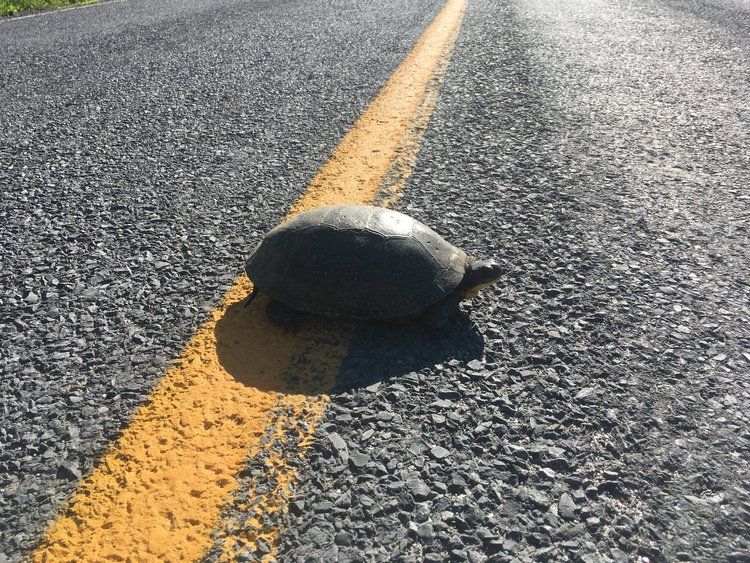
Why does the Turtle cross the Road?
It’s turtle season, and we’re in the thick of the best time of year to give turtles a helping hand! We are pleased to see all the turtle warriors out and about helping turtles cross the road safely, driving injured and deceased turtles to wildlife rehab centres, reporting turtle sightings, and even placing and monitoring nest protectors. Our team at Turtles Kingston has been buzzing with volunteer opportunities and determining where turtles could use our help. With all these activities going on centering around keeping turtles safe, it begs the question; why do turtles cross the road in the first place? Roads are one of the least safe places for turtles – road mortality is the second largest reason for turtle population loss – so why do we constantly find them there? Join us in exploring why turtles have to cross our roadways!
Turtles cross the road for five main reasons:
- Looking for a place to nest
2. Looking for a mate.
3. Trying to avoid predators
4. Moving within their habitat
5. Disturbed by humans
1) Looking for a place to nest
Our Nesting Program Coordinator James shows a nest protector, which are used to protect existing turtle nests. You may see some of these placed on roadside nests.
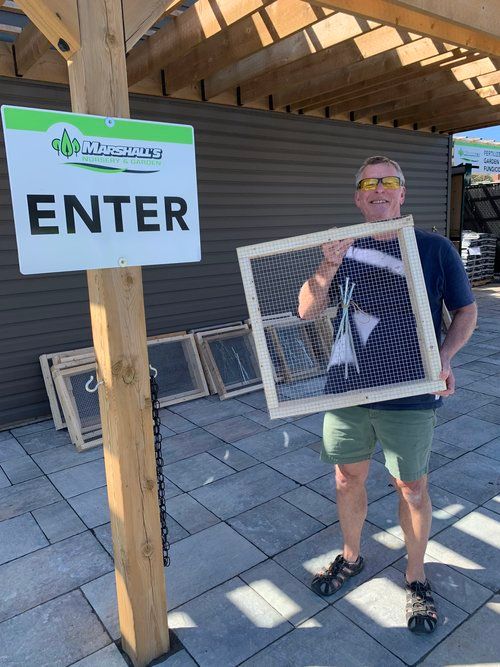
Female turtles instinctively look for a nesting place suitable for burying their eggs. An ideal turtle nesting place has loose substrate where the egg-bearing turtle can dig a hole, and exposure to sun so that the eggs can warm and incubate underground until they are ready to hatch. The length of time the eggs incubate before hatching depends on the species of turtle, and the weather conditions/temperatures when the eggs are incubating.
Beaches and shorelines meet the requirements for an ideal turtle nesting location, but unfortunately so does the shoulder of the road. Roadside gravel, grit, or dirt shoulders are both loose enough for turtles to dig in and are exposed to the sun. Unfortunately, this encourages turtles to venture over the road to reach the shoulder with its seemingly ideal nesting conditions. This puts the mother turtle at risk of injury or death on the road, and hatchlings that emerge from the nest have a higher chance of venturing onto the roadway as well.
After laying her eggs, the female turtle will leave the nest to re-enter her wetland habitat. This, once again, puts her into danger when crossing the road from the shoulder to return to her usual territory.
Did you know? A turtle’s sex is determined by the temperature of the nest when they are incubating. A long period of heat generally means that more hatchlings will be female.
2) Looking for a mate
Once a turtle has reached sexual maturity (this can take 8-20 years!), it will seek out a mate to reproduce with. Usually, male turtles will seek out mates when the weather warms up in the spring. Finding a mature female turtle to mate with requires travel, and inevitable road crossings as a turtle cannot travel more than 1.5 km in Ontario without encountering a road.


Did you know? During mating season a male painted turtle will use his nails to stroke a female turtle's head. If she approves, she will sink down into the water for mating to begin.
3) Trying to avoid predators
Despite having a protective shell, turtles are vulnerable to predators, particularly when they are hatchlings. Predators of Ontario turtles include raccoons, skunks, foxes, and coyotes. These predators can easily dig up a turtle nest or eat freshly emerged hatchlings. Hatchlings have a natural instinct to head for a body of water when they emerge from their eggs, which can put them in danger crossing the road to reach water.
Fortunately, adult turtles do not have too many natural enemies. This is particularly true when an adult turtle reaches a large size. Less than 1 in 100 hatchlings survives to grow into an adult turtle, mostly due to predation, so predators are still very much a threat to be considered.

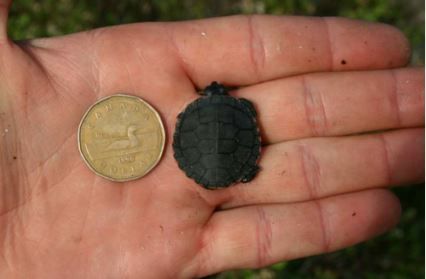
4) Moving within their habitat
Turtles’ habitats include lakes, ponds, marshes, rivers, and bogs. There is an obvious common theme here: turtle habitats require a body of water. Human development continues to destroy and remove wetlands, pushing turtles out of their habitats and putting them at risk while they travel and cross roads.
As we’ve discussed, turtles also move within their habitat to find mates, avoid predators, and lay their eggs. During the year, turtles also have to move within their habitats, often crossing roads, to return to the water when the weather cools down, to prepare to brumate. All turtles in Ontario go into a winter slumber – comparable to hibernation – called brumation. During brumation, turtles go to the bottom of a body of water, or deep under the mud. Their heart rates slow down during this time to approximately one beat per 10 minutes, and they breathe oxygen from the water through a special tail opening while they are in a state of brumation.
Turtles have many “tasks” during the year, all of which require walking to specific locations within their habitats, forcing them to cross roads in the process of moving from place to place.
Did you know? Here in Southern Ontario, we have the greatest diversity of turtles in Canada. What better reason to count ourselves lucky and do our best to respect and protect them!
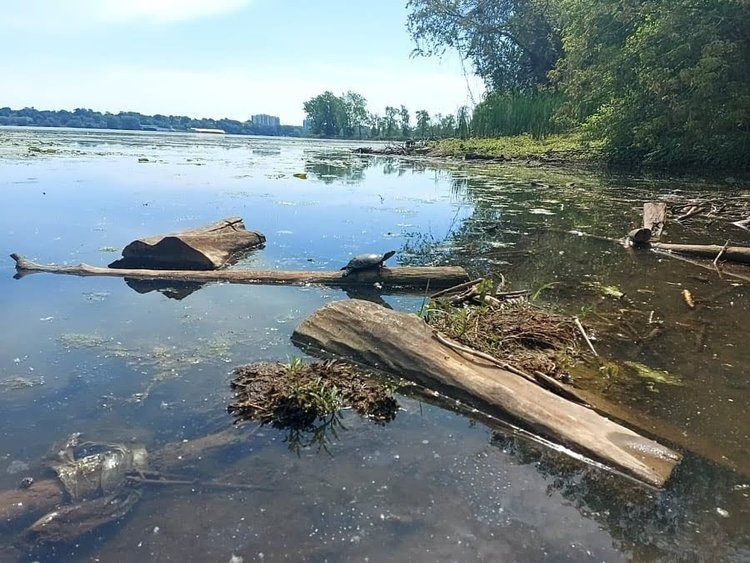
5) Disturbed by humans
The final main reason turtles cross the road is due to human disturbance. We touched on this briefly in the previous section; human development taking over wetlands pushes turtles away from their wetland habitats. Finding a new territory is stressful for a turtle that has been living in the same wetland for most of its life. As turtles seek out new territory and wetland, they are bound to cross roads and expose themselves to possible car strikes.
Well intentioned humans can also accidentally move a turtle out of its natural habitat while trying to help. It is very important that we, as turtle warriors helping turtles in the wild, do not move them any further than what it takes to keep them safe. This is why turtle conservation groups, including Turtles Kingston, have specific sets of instructions for moving turtles.
One must NEVER pick up a healthy, uninjured turtle and move it anywhere other than safely across the roadway in the direction that it was headed. Taking a turtle out of its territory can disorientate the turtle. It will seek its home territory, and it can be a perilous journey for the turtle, crossing roads in an attempt to find its way home. Turtles are equipped with a natural “GPS system” that prompts them to find their way home to their territories, which are often only a few acres and contain their familiar shelters, breeding grounds, and hibernation areas.
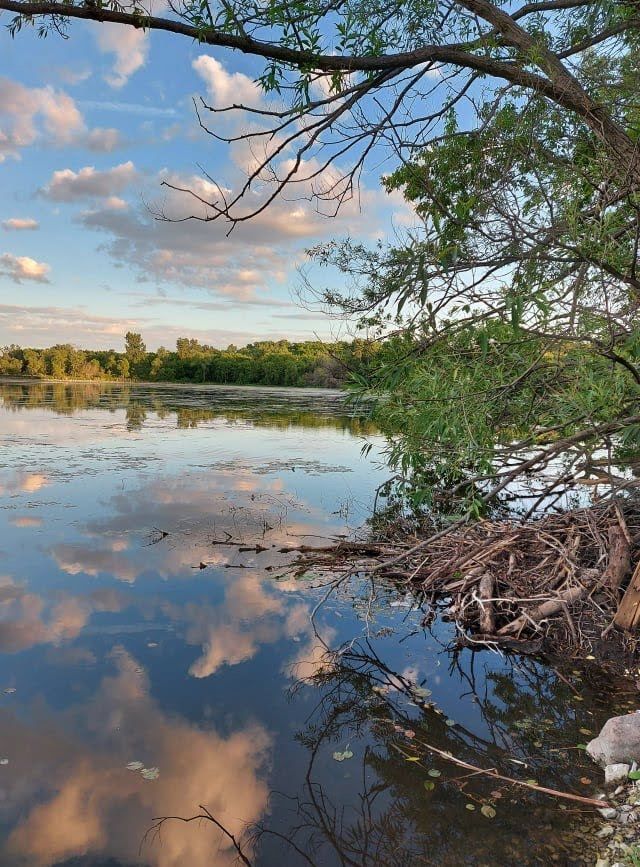
Similarly, if an injured turtle is found and brought to a wildlife rehabilitation centre, one must note the location that the turtle was found so that it can be re-released within its home habitat and continue on its natural pattern.
6) Call to Action!
We hope that we have shed some light on the reasons turtles are consistently found crossing the road, and that you learned something about the movements of your turtle neighbours. Now it’s up to all of us to help make these road crossings as safe as we can! One way to do this is to advocate for turtle awareness in your community. Speak to your friends and family members about how we can make a difference by helping turtles cross the road and helping turtles that have been struck by vehicles. Encourage people in your community to remember that turtles are species at risk and to keep an eye out for them on the road, to avoid hitting them and help when they can. Together, we call all make turtles’ lives safer!
By Nikki Kempen, Information Coordinator, Turtles Kingston
Nikki Kempen moved to Canada from South Africa as a child; she is a grocery store manager by day and runs a small pet and plant care business by night. She has a diploma in business management and zoology, and she has a passion for animal rescue and conservation.
Nikki currently volunteers at multiple animal rescues including Parrot Partners, Furry Tales Cat Rescue, and OURturtles seasonally. She has previously learned about sea turtle conservation and participated in sea turtle release in Mexico and she is excited to learn more about native turtle conservation here in Ontario.
TI Life expresses appreciation to Tara Bauer, Director for introducing us to Turtles Kingston and their important work. For more information be sure to review the Turtles Kingston website and particularly the Blog and the page "What Can You Do?"
Posted in: Volume 17, Issue 6, June 2022, Nature
Please click here if you are unable to post your comment.
